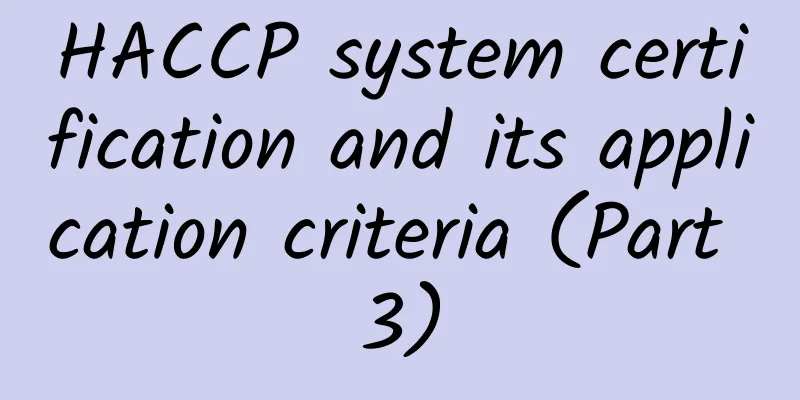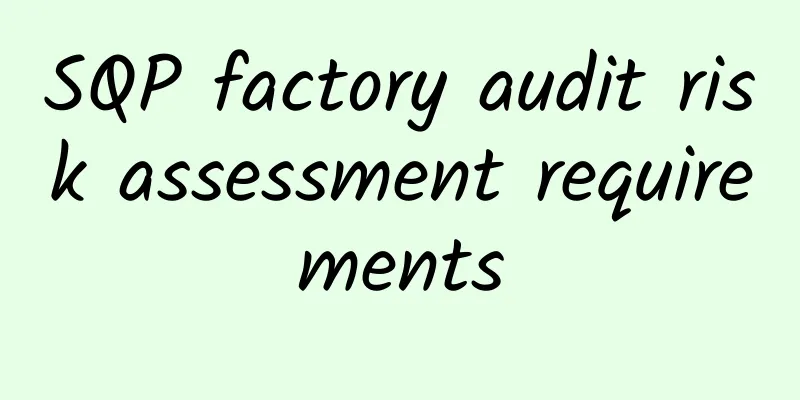HACCP system certification and its application criteria (Part 3)

|
HACCP system certification and its application criteria : VII. HACCP Plan Implementation Process 1. Establish a HACCP working group (1) The HACCP team is responsible for developing the HACCP plan and implementing and verifying the HACCP system. The composition of the HACCP team should ensure the relevant professional knowledge and experience required to establish an effective HACCP plan, and should include the company's leaders who specifically manage the implementation of the HACCP plan, production technicians, engineering technicians, quality management personnel, and other necessary personnel. Some small companies with insufficient technical strength can hire external experts. (2) The scope of the HACCP plan should be determined, i.e. the specific implementation links in the food supply chain and the general categories of hazards to be addressed (e.g. whether hazards are to be addressed selectively or all hazards are to be addressed). 2. Describe the product and determine its intended use. The first task of HACCP work is to describe the products for which the HACCP system management is implemented. The description includes: (1) Product name (specify the type of production process) (2) Raw materials and main ingredients of the product (3) Physical and chemical properties of the product (including aw, pH, etc.) and sterilization treatment (such as heat processing, freezing, salting, smoking, etc.) (4) Packaging method (5) Storage conditions (6) Shelf life (7) Sales method (8) Sales area (9) If necessary, epidemiological data on food safety (10) Intended use of the product and consumer groups 3. Draw and confirm the production process flow chart The HACCP working group should go deep into the production line to understand the production and processing of the product in detail, and on this basis draw a production process flow chart for the product. After production is completed, the flow chart needs to be verified on site. 4. Hazard Analysis (1) Hazard analysis can be divided into two activities - free discussion and hazard assessment. During the free discussion, the scope should be broad and comprehensive, including the raw materials used, each step of product processing and the equipment used, the final product and its storage and distribution methods, and how consumers use the product, etc. At this stage, all potential hazards that may occur should be listed as much as possible. Hazards that have no reason to occur will not be further considered in the HACCP plan. After the free discussion, the team evaluates the possibility and severity of each hazard to determine the significant hazards (with risk and severity) that are critical to food safety and include them in the HACCP plan. (2) Safety issues should be distinguished from general quality issues when conducting hazard analysis. Hazards involving safety issues that should be considered include: (3) Biological hazards include bacteria, viruses and their toxins, parasites and harmful biological factors (4) Chemical hazards Chemical hazards can be divided into four categories: naturally occurring chemicals, intentionally added chemicals, unintentionally or accidentally added chemicals, and hazardous chemicals produced during the production process. Natural chemicals: mycotoxins, histamine, etc. Intentionally added chemicals: food additives, preservatives, nutrient additives, color additives Chemicals added unintentionally or accidentally: Agricultural chemicals, banned substances, toxic substances and compounds, factory chemicals (lubricants, cleaning compounds, etc.) (5) Physical hazards: Any potentially harmful foreign matter not commonly found in food, such as glass, metal, etc. (6) List the hazard analysis worksheet The hazard analysis worksheet can be used to organize and clarify the ideas of hazard analysis. The HACCP working group should also consider what control measures can be taken for each hazard. 5. Identify critical control points The decision tree logic reasoning method is used to determine the critical control points (CCP) in the HACCP system. The application of the decision tree should be flexible, and other methods can also be used when necessary. If control of an identified hazard at a particular step is necessary to ensure food safety, but no corresponding control measures are in place at that step or at other steps, then the production or processing technology at that step or at steps before or after it must be modified to include the corresponding control measures. 6. Establish critical limits for each critical control point Each critical control point will have one or more control measures to ensure that the identified significant hazards are prevented, eliminated or reduced to an acceptable level. Each control measure will have one or more corresponding critical limits. The determination of critical limits should be based on science and can come from scientific journals, regulatory guidelines, experts, experimental studies, etc. The basis and references used to determine critical limits should be included as part of the HACCP plan support documents. The indicators commonly used for critical limits include: temperature, time, humidity, pH, water activity, salt content, sugar content, physical parameters, titratable acidity, available chlorine, additive content and sensory indicators such as appearance and odor. 7. Establish a system to monitor each critical control point Monitoring can detect if a critical control point is out of control. In addition, monitoring can provide the necessary information to adjust the production process in time to prevent the critical limit from being exceeded. Operational limits are tighter limits than critical limits and are used by operators to reduce the risk of deviation. Processing procedures should be adjusted when the operational limits are exceeded to avoid violating the critical limits. These measures are called processing adjustments. Processors can use these adjustments to avoid loss of control and avoid taking corrective actions. Early detection of out-of-control trends and taking action can prevent product rework or, in worse cases, product scrapping. Corrective actions are only taken when critical limits are exceeded. Design of a monitoring system. It is necessary to determine: (1) Monitoring content: Usually evaluate whether the operation of a CCP is within the critical limit through observation and measurement. (2) Monitoring methods: The monitoring measures designed must be able to provide results quickly. Physical and chemical tests can be performed faster than microbiological tests and are good monitoring methods. Common physical and chemical monitoring indicators include time and temperature combinations (often used to monitor the effectiveness of killing or controlling the growth of pathogens), water activity: (aW) (the growth of pathogens can be controlled by limiting water activity). Therefore, samples can be collected to test their water activity. Acidity or pH value (a certain pH level can limit the growth of pathogens), sensory inspection (an intuitive method of testing food). (3) Monitoring equipment: such as thermometers and hygrometers, clocks, balances, pH meters, water activity meters, chemical analysis equipment, etc. (4) Monitoring frequency: Monitoring can be continuous or non-continuous. If possible, continuous monitoring should be adopted. Continuous monitoring is feasible for many physical or chemical parameters. If monitoring is not continuous, the number or frequency of monitoring should ensure that the critical control point is under control. (5) Monitoring personnel: Personnel who can monitor CCPs include: personnel on the assembly line, equipment operators, supervisors, maintenance personnel, quality assurance personnel, etc. Personnel responsible for monitoring CCPs must receive training on CCP monitoring technology, fully understand the importance of CCP monitoring, be able to conduct monitoring activities in a timely manner, accurately report each monitoring work, and report violations of critical limits at any time so that corrective actions can be taken in a timely manner. 8. Establish corrective measures (1) In the HACCP plan, corresponding corrective measures should be established in advance for each critical control point so that they can be implemented when deviations occur. (2) Corrective measures should include: (1) determining and correcting the cause of the deviation; (2) determining the treatment method for the products involved in the deviation period, such as isolation and storage and safety assessment, return of raw materials, reprocessing, destruction of products, etc.; (3) recording corrective actions, including product confirmation (such as product treatment, number of retained products), description of the deviation, corrective actions taken including the final treatment of the affected products, the name of the person taking the corrective action, and necessary evaluation results. 9. Establish a verification process Verification, review and inspection (including random sampling) can determine whether HACCP is operating correctly. The verification procedure includes verification of CCP and verification of HACCP system. (1) CCP verification activities. ① Calibration: CCP verification activities include the calibration of monitoring equipment to ensure the accuracy of the measurement methods adopted. ② Review of calibration records: Review the calibration records of the equipment, including the inspection date and calibration method, as well as the test results. The calibration records should be saved and reviewed. ③Targeted sampling and testing. ④Review of CCP records. (2) HACCP system verification ① Verification frequency: The verification frequency should be sufficient to confirm that the HACCP system is operating effectively. It should be carried out at least once a year or when a system failure occurs, when there is a significant change in product raw materials or processing, or when a new hazard is discovered. ② System verification activities: Check the accuracy of product descriptions and production flow charts; check whether CCPs are monitored as required by HACCP; whether monitoring activities are performed at the locations specified in the HACCP plan; whether monitoring activities are performed at the frequency specified in the HACCP plan; whether corrective actions are taken when monitoring indicates deviations from critical limits; whether equipment is calibrated at the frequency specified in the HACCP plan; whether the process operates within established critical limits; check whether records are accurate and completed within the required time, etc. 10. Create files and records Generally speaking, the records that must be kept under the HACCP system should include: (1) Hazard Analysis Summary: Includes written hazard analysis worksheets and records of any information used to conduct the hazard analysis and establish critical limits. Supporting documentation may also include: sufficient data used in developing methods to inhibit the growth of bacterial pathogens, data used to establish the safe shelf life of the product, and data used in determining the intensity of heating to kill bacterial pathogens. In addition to data, supporting documentation may also include letters of consultation with relevant consultants and experts. (2) HACCP plan: including the list of HACCP working group and related responsibilities, product description, confirmed production process flow and HACCP summary. The HACCP summary should include the product name, the step where the CCP is located and the name of the hazard, critical limits, monitoring measures, corrective measures, verification procedures and record keeping procedures. (3) All records occurring during the implementation of the HACCP plan. (4) Other supporting documents such as verification records, including revisions to the HACCP plan. 8. Publicity and Training 1. The health administrative department shall carry out HACCP knowledge education for the public. 2. Health technicians and food companies should regularly provide HACCP training to relevant personnel within the system. IX. Others 1. Food companies should combine the implementation of HACCP with the transformation of their infrastructure and technology. 2. HACCP is aimed at specific products and production processes. If the production process changes, the company should modify some of the contents of HACCP based on actual conditions. 3. The appendix of this guide provides a series of HACCP plan forms for reference when enterprises implement HACCP. The specific format of these forms can be flexible and can also be organically integrated into the specific implementation documents of the enterprise's existing quality management system. The above content is the final part of the introduction about HACCP system certification and its application criteria. If you want to know the complete factory inspection information in this regard, you can refer to the contents of HACCP system certification and its application criteria (I) and HACCP system certification and its application criteria (II). |
<<: The main differences between Wal-Mart factory inspection and THE HOME DEPOT factory inspection
>>: Should I do HACCP certification or ISO22000 certification?
Recommend
How is Ambow Accounting? What services does Ambow Accounting provide?
How is Ambow Accounting? Founded in London, UK, A...
What can bus companies do to pass TS16949 certification?
What can bus companies do to pass TS16949 certific...
The latest BSCI factory inspection standards
1. Floor plan of the factory and dormitory 2. Bus...
Real.de--German e-commerce platform
Real.de was founded in 2017 and is sold in 30 cou...
What is SHEIN? What are the advantages of the SHEIN platform?
What is SHEIN? SHEIN is a cross-border B2C fast f...
Customer factory audit - Chicos factory audit behavior standards
Chicos Factory Audit Standards of Conduct 1. Legal...
How is Neptune Supply Chain? What services does Neptune Supply Chain provide?
How about Neptune Supply Chain? Neptune Supply Ch...
What are the Matson Clippers? Why are they so fast?
What are the Matson Clippers? Matson Express was ...
How is Huahan Logistics? What services does Huahan Logistics provide?
How about Huahan Logistics? Shenzhen Huahan Hongy...
What is Daraz? Daraz registration process
Currently, Daraz has opened sites in five countri...
Tchibo factory audit information
1. Tchibo factory inspection company certificatio...
JCPenney Catalog Paper Policy
Another important policy related to JCPenney and ...
Popular Science! What is eBay?
As the second largest cross-border e-commerce pla...
What is EMC certification? What are the EMC design measures?
What is EMC certification? EMC certification is t...
Pepper Content—Intelligent content matching platform
What is PepperContent? Founded in 2017, PepperCon...









